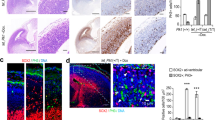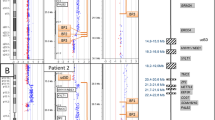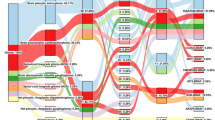Abstract
With the exception of the X chromosome, genomic deletions appear to be more prevalent than duplications. Because of a lack of accurate diagnostic methods, submicroscopic duplications have been under-ascertained for a long period. The development of array CGH has enabled the detection of chromosomal microduplications with nearly the same sensitivity as deletions, leading to the discovery of previously unrecognized syndromes. Using a clinical targeted oligonucleotide array (CMA-V6.3 OLIGO), we identified an ∼360-kb duplication in 9q22.32 in a 21-month-old boy with developmental delay, failure to thrive, and microcephaly. The same duplication was identified in the patient's mother who is also microcephalic and mildly delayed. We have sequenced the chromosomal breakpoints and determined the duplication as tandem in orientation and 363 599 bp in size. The duplicated segment harbors the entire PTCH1 gene. Deletions or loss-of-function mutations of PTCH1 result in basal cell nevus syndrome (Gorlin syndrome), whereas gain-of-function mutations were proposed to lead to holoprosencephaly 7. We propose that patients with microcephaly or holoprosencephaly of unknown origin should also be screened for PTCH1 duplication.
Similar content being viewed by others
Log in or create a free account to read this content
Gain free access to this article, as well as selected content from this journal and more on nature.com
or
References
Gorlin RJ, Goltz RW : Multiple nevoid basal-cell epithelioma, jaw cysts and bifid rib: a syndrome. N Engl J Med 1960; 262: 908–912.
Gorlin RJ : Nevoid basal cell carcinoma syndrome. Medicine 1987; 66: 98–113.
Hahn H, Wicking C, Zaphiropoulos PG et al: Mutations of the human homolog of Drosophila patched in the Nevoid Basal Cell Carcinoma syndrome. Cell 1996; 85: 841–851.
Johnson RL, Rothman AL, Xie J et al: Human homolog of patched, a candidate gene for the basal cell nevus syndrome. Science 1996; 272: 1668–1671.
Lindström E, Shimokawa T, Toftgård R, Zaphiropoulos PG : PTCH1 mutations: distribution and analyses. Hum Mutat 2006; 27: 215–219.
PTCH1 mutation database http://www.cybergene.se/PTCH/.
Nowakowska B, Kutkowska-Kaźmierczak A, Stankiewicz P et al: A girl with deletion 9q22.1–q22.32 including the PTCH1 and ROR2 genes identified by genome-wide array-CGH. Am J Med Genet A 2007; 143: 1885–1889.
Fujii K, Ishikawa S, Uchikawa H et al: High-density oligonucleotide array with sub-kilobase resolution reveals breakpoint information of submicroscopic deletions in nevoid basal cell carcinoma syndrome. Hum Genet 2007; 122: 459–466.
Ou Z, Kang SH, Shaw CA et al: Bacterial artificial chromosome-emulation oligonucleotide arrays for targeted clinical array-comparative genomic hybridization analyses. Genet Med 2008; 10: 278–289.
Soufir N, Gerard B, Portela M et al: PTCH1 mutations and deletions in patients with typical nevoid basal cell carcinoma syndrome and in patients with a suspected genetic predisposition to basal cell carcinoma: a French study. Br J Cancer 2006; 95: 548–553.
Ming JE, Kaupas ME, Roessler E et al: Mutations in PATCHED-1, the receptor for SONIC HEDGEHOG, are associated with holoprosencephaly. Hum Genet 2002; 110: 297–301.
Ribeiro LA, Murray JC, Richieri-Costa A : PTCH1 mutations in four Brazilian patients with holoprosencephaly and in one with holoprosencephaly-like features and normal MRI. Am J Med Genet A 2006; 140: 2584–2586.
Stone DM, Hynes M, Armanini M et al: The tumour-suppressor gene patched encodes a candidate receptor for Sonic hedgehog. Nature 1996; 384: 129–134.
Taipale J, Cooper MK, Maiti T, Beachy PA : Patched acts catalytically to suppress the activity of Smoothened. Nature 2002; 418: 892–897.
Lazaro L, Dubourg C, Pasquier L et al: Phenotypic and molecular variability of the holoprosencephalic spectrum. Am J Med Genet A 2004; 129: 21–24.
Stashinko EE, Clegg NJ, Kammann HA et al: A retrospective survey of perinatal risk factors of 104 living children with holoprosencephaly. Am J Med Genet A 2004; 128: 114–119.
Muenke M, Gurrieri F, Bay C et al: Linkage of a human brain malformation, familial holoprosencephaly, to chromosome 7 and evidence for genetic heterogeneity. Proc Natl Acad Sci USA 1994; 91: 8102–8106.
Roessler E, Belloni E, Gaudenz K et al: Mutations in the C-terminal domain of Sonic Hedgehog cause holoprosencephaly. Hum Mol Genet 1997; 6: 1847–1853.
Acknowledgements
We thank Dr Sung-Hae Kang for helpful discussion.
Author information
Authors and Affiliations
Corresponding author
Rights and permissions
About this article
Cite this article
Derwińska, K., Smyk, M., Cooper, M. et al. PTCH1 duplication in a family with microcephaly and mild developmental delay. Eur J Hum Genet 17, 267–271 (2009). https://doi.org/10.1038/ejhg.2008.176
Received:
Revised:
Accepted:
Published:
Issue date:
DOI: https://doi.org/10.1038/ejhg.2008.176
Keywords
This article is cited by
-
Schilbach–Rott syndrome associated with 9q22.32q22.33 duplication, involving the PTCH1 gene
European Journal of Human Genetics (2019)
-
Chromosomal microarray analysis as the first-tier test for the identification of pathogenic copy number variants in chromosome 9 pericentric regions and its challenge
Molecular Cytogenetics (2016)
-
Hedgehog signaling promotes basal progenitor expansion and the growth and folding of the neocortex
Nature Neuroscience (2016)



